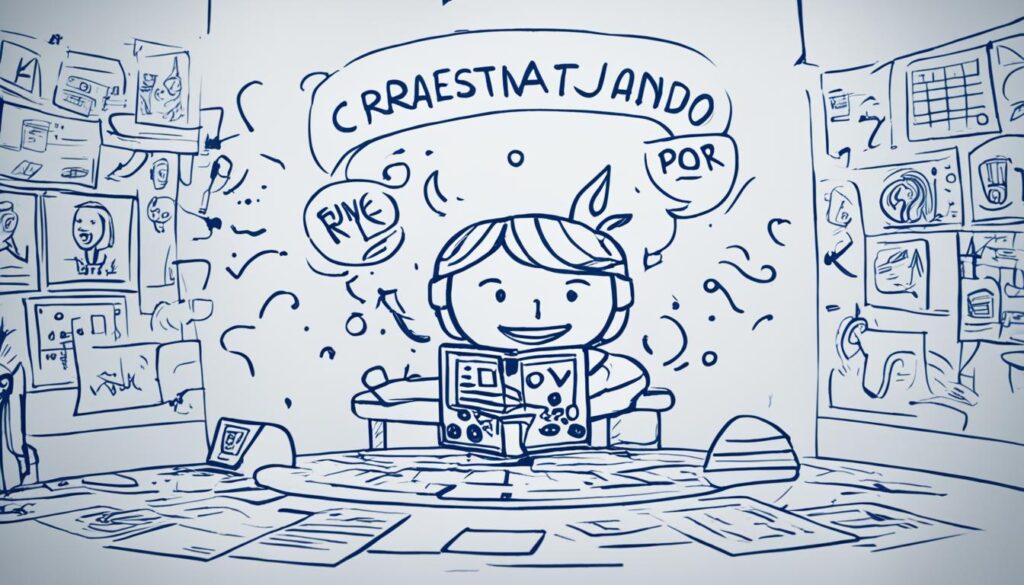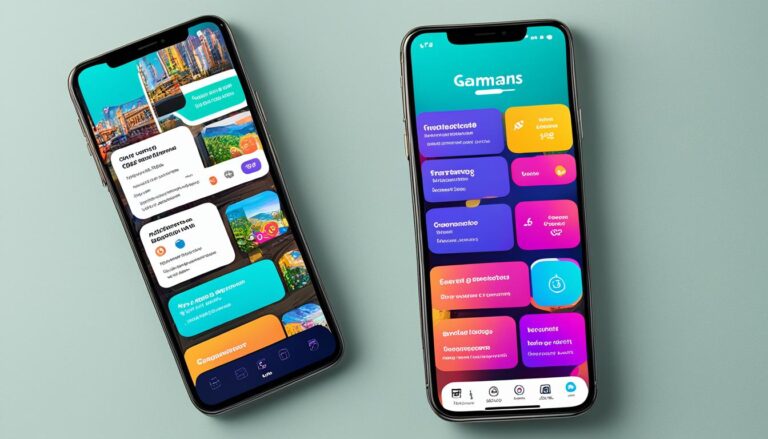From Script to Screen: Crafting Effective Messages with Animation
Making a great animated explainer video is more than just pretty graphics and smooth moves. It begins with a strong script that’s the heart of your message. In this article, we’ll cover the essentials of writing a script for an animated video. We’ll talk about knowing your audience and using storytelling to connect.
A script that grabs attention, delivers your message clearly, and encourages action can make your animated video successful. Let’s learn how to create messages that impact your audience and leave a mark.
Key Takeaways:
- Know your audience and understand their needs, goals, and interests.
- Clearly define your objective and the main message you want to convey.
- Utilize storytelling techniques to connect with your audience emotionally.
- Use simple language that is easy to understand and promotes inclusivity.
- Keep your script concise and leverage visual storytelling elements.
Know Your Audience
Starting with a script for your animated video means understanding who you’re talking to. It’s about knowing what your audience needs, what bothers them, and what they enjoy. This allows you to make something that truly connects with them. A good foundation lets you speak their language and grab their attention.
When you know your audience, you can make your video just for them. Are you aiming at millennials who like quick videos, or business folks who prefer a formal approach? This knowledge helps you choose the right tone and style. This way, you connect more deeply.
Gather insights through market research and real conversations with your audience. This helps you exceed their expectations with your script. This step is crucial for a script that truly stands out.
Your animated video should talk directly to your viewers’ needs and wants. Keeping your audience in focus means your video will not only grab attention but also build trust and spark action.
The Importance of Understanding Your Target Audience
Remember, your audience is made up of individuals with different likes and problems. Acknowledging these differences means your content will resonate more. This approach hits the right notes with your viewers.
“Understanding your audience allows you to tailor your video to their specific needs and preferences.”
Take making a video for a fitness app as an example. You might adjust your script for stay-at-home moms, college students, or retirees. This shows the importance of knowing who you’re talking to.
By understanding your audience, you can establish a real connection. Talk about their issues, give solutions, and use their language. This personal touch builds trust and cements your brand’s authority.
In the end, knowing your audience makes your video fulfill its goal. This ensures your message is clear, your viewers are engaged, and they’re driven to act.
Define Your Objective
Starting with a clear objective is key when you make an animated video. Make sure to outline your video’s purpose and key messages early on. This could be to educate, entertain, inspire, or persuade your audience. A clear goal helps guide your script from the beginning.
Understanding your video’s objective helps match your content and visuals to your intended impact. Consider how you want viewers to feel after watching. Should they be informed, motivated, or curious? This way, you can craft a script that effectively delivers your message and grabs your audience’s attention.
Having a solid objective keeps you on track and weeds out any distractions. It makes sure that every part of your video, including both script and visuals, focuses on your main goal. Also, it lets you create a forceful call to action that supports your video’s aim and moves viewers to act.
Importance of Defining Your Objective
Setting a clear objective is vital for a successful animated video. Here are the reasons:
- Clarity: A definite goal helps make your message clear and direct. It streamlines your script, ensuring every scene advances your main aim.
- Focus: With a goal in mind, your narrative stays concentrated. This stops your script from meandering off topic.
- Relevance: A specific objective ensures your video meets your audience’s wants and needs. It connects directly to their concerns, offering solutions.
- Memorability: A clear objective helps make your message stick. A concise, impactful video is more likely to be remembered and shared.
A defined objective lays the groundwork for a meaningful animated video. It’s the key to sharing your main message, engaging your audience, and prompting action.
Example of a Script Objective:
“Our goal is to teach small business owners about social media’s perks through animation. We’ll show how it boosts business growth, enhances brand presence, and connects with customers. Our aim is for viewers to feel inspired to use social media for their business success.”

Write a Story
To make an animated video script captivating, use storytelling. It’s a great way to connect with your viewers. Have a clear beginning, middle, and end to keep your viewers engaged and make an impact.
Start with a main character, a problem, and how it gets solved. Stories with these elements touch hearts and simplify your message. It makes your content accessible and relatable to your audience.
Storytelling builds a bridge to your viewers, creating unforgettable moments. By telling a story they see themselves in, you pull them closer. You spark an emotional chord, grabbing their attention and motivating them to act.
Include these elements in your script for storytelling:
- Character development: Create characters your audience will cheer for.
- Plot progression: Add suspense or curiosity to hook your viewers.
- Conflict resolution: End the story by solving the problem, offering closure.
- Emotional appeal: Use emotions to connect with your viewers on a deeper level.
- Visual storytelling: Enhance your story with visuals and animations.
Storytelling grabs your audience’s attention and forges strong bonds. A compelling story will stir emotions, create connections, and share your message clearly.
Writing your script as a story can deeply connect with your audience. Think about who they are and what they like. Make sure your story matches what they care about and believe in.
Now, we’ll look at why simple language in your script is key. It helps communicate clearly and keeps your audience engaged.
Use Simple Language
When making a script for a video, clear communication is key. Use easy words and short sentences. This helps make sure your message is clear, remembered, and acted on.
Stay away from hard terms, short forms, and jargon. Use words everyone can understand. Remember, your audience has different backgrounds. So, use language that’s inclusive. This way, everyone can get your message.
“Simplicity is the ultimate sophistication.” – Leonardo da Vinci
Writing simply lets your audience connect better with your video. It makes your message easier to get and remember. Plus, it boosts the clarity and power of your video.

Be Concise
Writing your script for an animated video means being concise. Your script must be short, appealing, and to the point. This ensures your message gets across clearly in a short time. Cut out any extra details or unnecessary words that might lose your audience’s interest.
Animation relies on visual storytelling. So, rather than just telling your viewers what they need to know, show them with interesting visuals. Vibrant illustrations and dynamic animations can grab their attention. This helps them understand your message better.
It’s important to balance audio and visuals in your video. Voiceovers and sound effects are key in sharing your message. But visuals have a big role too. They can make your script’s main points stand out. This creates a video experience viewers will remember.
Your goal is to keep the audience engaged. Make your script interesting from start to finish. Use stories with problems and solutions. This way, you can catch your viewers’ interest and connect with them.
Short and Engaging
Long sentences can make you lose your audience. Instead, choose short and strong words to share your message. Break down big ideas into smaller pieces. This makes it easier for everyone to get your point.
By keeping your script concise and engaging, you create a video that grabs your viewers’ attention, holds it throughout, and leaves a lasting impact.
Emotive language can make a big difference. It can make viewers feel excited, inspired, or empathetic. Connecting emotionally makes your animated video more powerful. It makes viewers more likely to remember your message.
Summary:
In summary, make your animated video script brief, use visuals well, and write a story that grabs attention. This way, you can make a memorable video. A video that not only shares your message but also makes a big impression.
Read it Aloud
Reading your script aloud is key to making a great animated video. It helps you see if the words flow well and are clear. You also get to check the rhythm, tone, and speed, making sure they match your message. This way, you keep the audience hooked. Reading out loud lets you catch errors, inconsistencies, and awkward phrases that you might miss otherwise.
When you read aloud, you imagine how the script comes to life in animation. It helps you think of the visuals that go with the words. This lets you see where you might need more details or descriptions. Also, hearing your script helps you know if your story tells well and makes an impact.
Having someone else read your script is a good idea too. They can give you a new view and point out parts that could be better. They’ll help you see if your story flows well, if it’s easy to understand, and if it gets your point across.
Don’t overlook the importance of reading your script out loud. It’s a vital part of editing. It helps you polish your words, fine-tune the dialogue, and make sure every word matters. This way, you create a script that grabs attention, shares your message clearly, and motivates people to act.
Key Points:
- Reading your script aloud helps you check the flow, tone, and clarity of your script.
- It allows you to spot errors, inconsistencies, and awkward phrases.
- Reading aloud helps you envision how your script will sound and look when it is animated.
- Consider asking someone else to read your script aloud for additional feedback.
- Use the insights gained from reading aloud to refine and improve your script.
Collaboration and Feedback
Working closely with illustrators, animators, and voice actors is key. This teamwork makes sure the visuals and audio in your animated video blend well. Together, they effectively share your message.
To boost the video’s quality and impact, setting up regular feedback loops is vital. Getting thoughts and suggestions from everyone helps. This way, you can tweak and enhance your work based on their insights.
Welcoming creative ideas from your team is important. Their unique views can make your animated explainer video better. Discussing and valuing their suggestions could lead to innovative solutions that boost your video’s appeal.
The Power of Collaboration
Collaborating is crucial for a top-notch animated explainer video. It lets you use the strengths and skills of your team to create something great. Everyone’s ideas matter in this open, transparent communication culture.
Effective collaboration brings different creative aspects together seamlessly. It combines storytelling, visuals, and audio into a powerful message. This resonates well with the audience.
The Importance of Feedback
Having regular feedback is key to improving your script and animation. It ensures your video clearly gets your message across. Welcoming constructive criticism helps gather useful insights, contributing to your video’s success.
Feedback helps spot what needs work, refine your script and visuals, and better the overall effect of your video. Seeing feedback as a chance for growth and teamwork leads to a more refined outcome.
Focus on collaboration and feedback during your project. This approach will help you create an engaging animated explainer video. It’ll share your message well and meet your goals.
Conclusion
Making a good animated explainer video needs a smart plan. Know who you’re talking to, what you want to say, and use storytelling. This helps you make a great video that shares your message well and grabs your audience.
To connect with your audience, you need to understand what they like and need. Write your video script to solve their problems and reach their goals. Use clear and simple words. By keeping your message short and using visuals in your story, you can make your point stand out.
It’s important to work together and listen to feedback while making the video. Team up with artists, animators, and voiceover artists to make your script and animations work well together. Open up to new ideas from everyone involved to make your video better and more effective.
In short, a careful and detailed approach can help you make an animated video that really gets your message across, catches your viewers’ attention, and gets them to act. Craft your script well, using storytelling and easy-to-understand language. Also, work with your team and consider their feedback to make your video strong and engaging.







